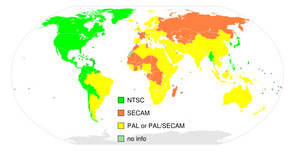WikiBot@legacy41983286 (talk | contribs) (Moving notices templates to our new Special:Flags feature.) |
BritishCynic (talk | contribs) No edit summary |
||
| (6 intermediate revisions by 3 users not shown) | |||
| Line 1: | Line 1: | ||
| + | {{ElementInfobox |
||
| − | [[Image:NTSC-PAL-SECAM.png|thumb|right|PAL regions and NTSC regions]] |
||
| + | | image = NTSC-PAL-SECAM.png |
||
| ⚫ | Short for '''P'''hase '''A'''lternating '''L'''ine, the television standard in [[Europe]], [[Australia]] and |
||
| + | | caption = PAL, SECAM and NTSC regions |
||
| − | __FLAGS__ |
||
| − | + | | type = Terminology |
|
| + | }} |
||
| + | |||
| ⚫ | Short for '''P'''hase '''A'''lternating '''L'''ine, '''PAL''' is the television standard in [[Europe]], [[Australia]] and most of [[Asia]] (with [[Japan]] as the exception). The [[United States]] and [[Japan]] use a different standard, [[NTSC]]. Whereas NTSC delivers 525 lines of [[resolution]] at 60 half-frames per second, ''PAL'' delivers 625 lines at 50 half-frames per second. Many video adapters that enable computer monitors to be used as television screens support both NTSC and PAL signals. |
||
| + | |||
| + | The PAL format is especially important for emulation, since early games marked as European were encoded specifically to run in PAL mode, while video games marked as Japanese or North American were encoded specifically to run in NTSC mode. |
||
Revision as of 21:18, 15 May 2020
| PAL | |
|---|---|
 PAL, SECAM and NTSC regions | |
| Basic Information | |
Type(s) |
Terminology |
Short for Phase Alternating Line, PAL is the television standard in Europe, Australia and most of Asia (with Japan as the exception). The United States and Japan use a different standard, NTSC. Whereas NTSC delivers 525 lines of resolution at 60 half-frames per second, PAL delivers 625 lines at 50 half-frames per second. Many video adapters that enable computer monitors to be used as television screens support both NTSC and PAL signals.
The PAL format is especially important for emulation, since early games marked as European were encoded specifically to run in PAL mode, while video games marked as Japanese or North American were encoded specifically to run in NTSC mode.
